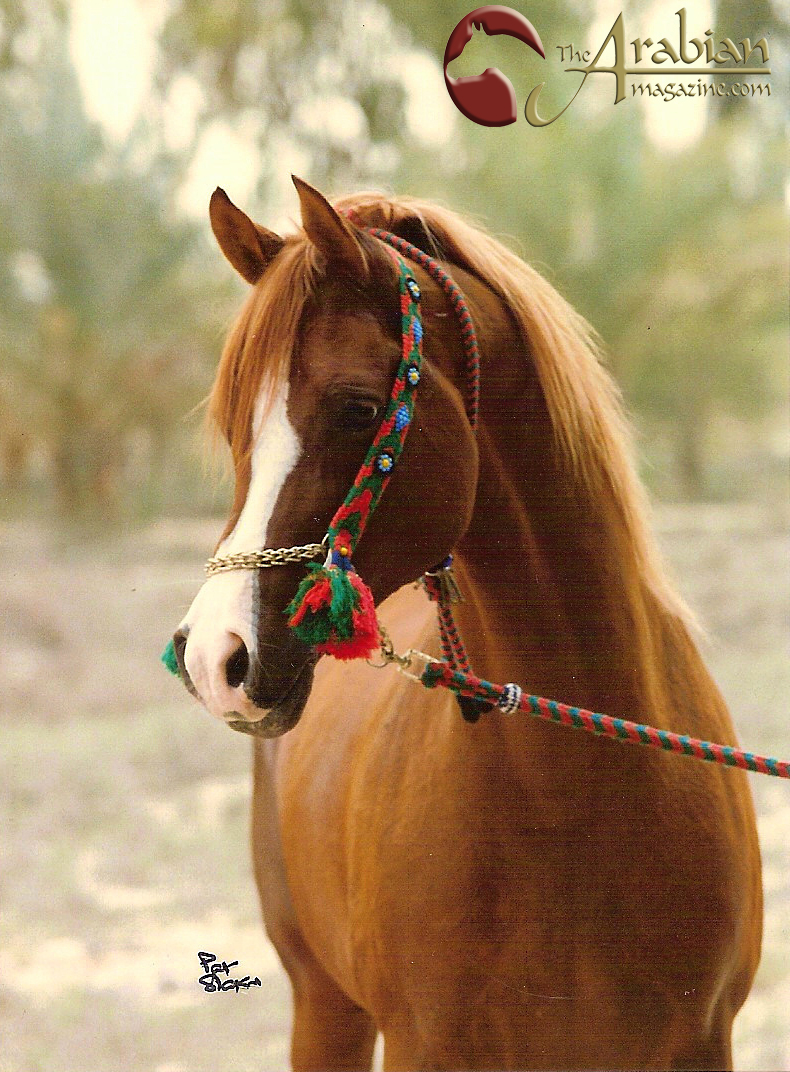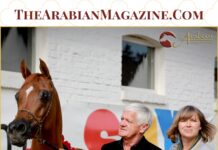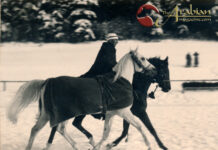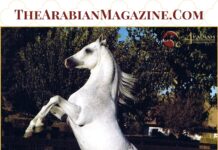With WAHO Abu Dhabi ending in the middle of April, we thought we would share this treasure from our archives – Barry Shepherd’s look back at The Royal Stables of the late HH Sheikh Zayed bin Sultan al Nahyan. We first ran this in The Arabian Magazine in 2009 and again in The Arabian Breeders’ Magazine in 2022. Please enjoy the second part of our look back at this most iconic stables. You can find part one here.
The sires
A wonderful stallion was bred in the UK in 1982 and like so many of the best, was sold abroad at a young age. Nejma Zomorrod was gifted to HH Sheikh Zayed from the King of Saudi Arabia in 1987, and he caused quite a stir among the Emirates who were mesmerised by his beauty. He was sired by the Egyptian stallion Shakhs (Morafic x Shiaa) and was out of the English mare Clear Blue (Manto x Crystal Clear). Nejma Zomorrod was tragically taken from the stud only a few years later when he slipped while being washed and broke his neck. In that time, he sired only a handful of foals including the stunning Walad Jarrah II, the first local bred to win an international race in the Emirates.
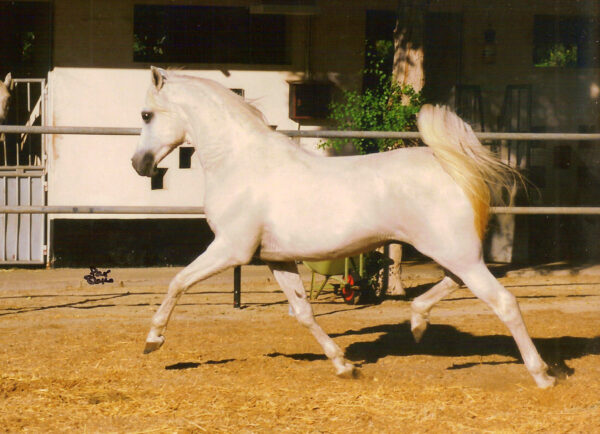
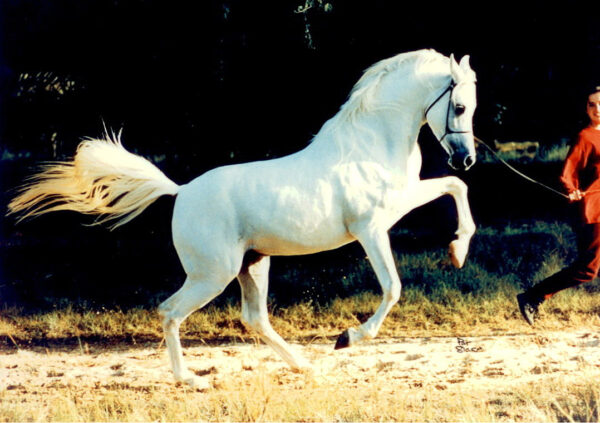
HH Sheikh Zayed was looking through Arabian Horse World and saw a photograph of a young typey, fire-red chestnut stallion named Padron (Patron x Odessa). After making investigations into this stallion, the task was given to Jane Kadri to find a horse of equal magnitude and after much searching, Aboud [cover photograph] was the chosen one. Sired by Diamond Star and out of British National Champion Azeme Bint Gleam (by Silver Flame), Aboud was a 1982 chestnut stallion of classically bred English lines. Imported in 1992, he had a massive impact on the stud and he fitted perfectly into Sheikh Zayed’s philosophy. Aboud only produced 59 foals in his lifetime, and 26 for the Royal Stables, as opposed to Padron’s 803. He was truly an unsung hero in the Arabian horse world and it may have been a very different scenario had Aboud landed on different shores. Aboud himself had a beautiful, long, arched neck, huge coal-black eyes and more than his fair share of arrogance; the slightest noise and his tail would go over his back, a trait he passed on to his offspring. His last public appearance was at the British Nationals in 2004 when, due to traffic circumstances, he missed the judging, but was allowed into the arena to a crescendo of cheering, such was his brilliance. He was a first-class show horse and won twice the Ridden Championship in Qatar and Abu Dhabi. But as a breeding stallion, he was astoundingly pre-potent. His daughters were not only exotically beautiful athletic Arabians but also fantastic broodmares. Sheikh Zayed’s aim was to breed horses such as this and Aboud never once disappointed.
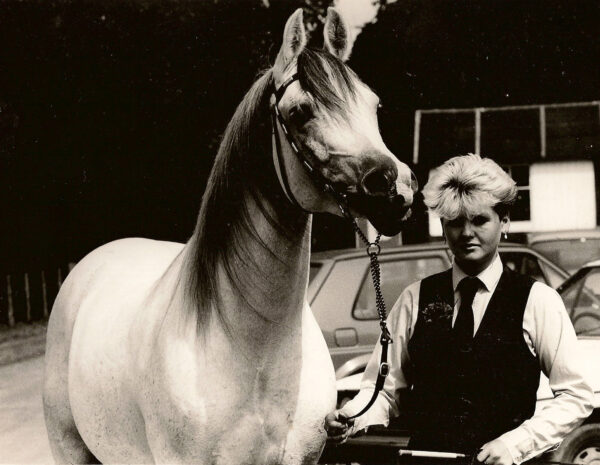
Along with Aboud came his new stablemate Vain Hussar, a 1979 grey stallion by Ragos (Argos x Rabiha) and out of Mirella (Rayyan x Rumani). He had old English/Polish/Bahraini bloodlines and before arriving in the UAE in 1989, he was British National Champion Ridden Stallion and went onto become the 1990 Champion Stallion at the Middle East Championships in Jordan. Vain Hussar was famously painted with Sheikh Zayed on his back; this has become a major symbol of the country today and it can still be seen on many billboards across the Emirates. It may be noted that both these stallions were what the present day judge would class as a little soft in the back, but this was a trait that Sheikh Zayed prized saying: “This fad for a tabletop level back may look desirable, but it lacks the power and strength of movement that sets these wonderful animals apart”. Many years ago, when Abu Dhabi was still a small city with miles of sandy tracks winding their way to the Arabian Gulf, Sheikh Zayed’s sons would often fight to ride these wonderful stallions. It was a common sight to see the now Crown Prince of Abu Dhabi and his little brother, now the Deputy Prime Minister of the UAE, riding along the streets in the cool evening breeze.
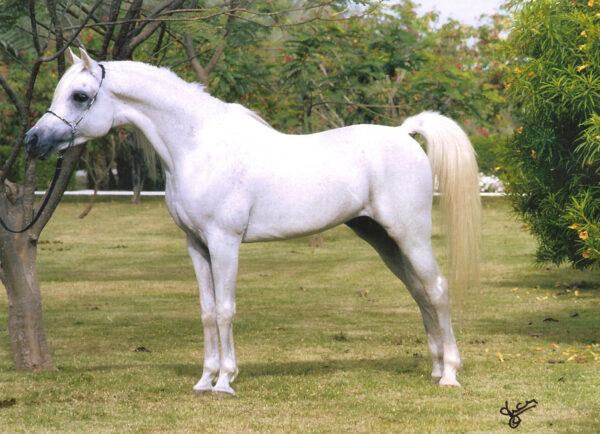
In 1993, the search for a new stallion led back to England when the World Champion, All Nations’ Cup Champion and British National Champion Maleik el Kheil secured his famous position in the Abu Dhabi breeding barn. He was named leading sire at the British Nationals no fewer than six times and has continued this trend around the globe. While Maleik was of El Shaklan’s first foal crop in England in 1979, the other side of Europe in the northern Caucuses in Russia, saw the birth of Pakistan, son of Kumir (Mak x Kapella) and out of the celebrated Panagia (Aswan x Pustinia). This silver-grey stallion was a true gentleman and died at the ripe old age of 28. He was maternal half-brother to the Tersk sire Aspirant (by Naslednik), US National Champion Princip (by Nabeg) and the horse of the century, Balaton (by Menes). While one of the chief sires at Tersk, Pakistan sired some top-class Arabians including Bespechni (ex Bionika), who was named Qatar International Champion and British National Champion Stallion. Pakistan himself was named British National Champion Reserve Stallion while at the Maxwell’s on his stopover from Russian to the Middle East. He sired a multitude of winners during his time at the Royal Stables.
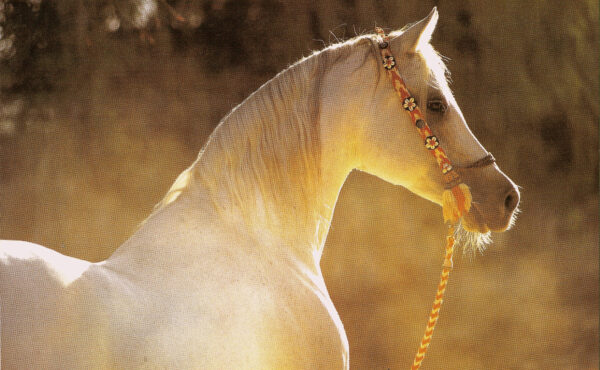
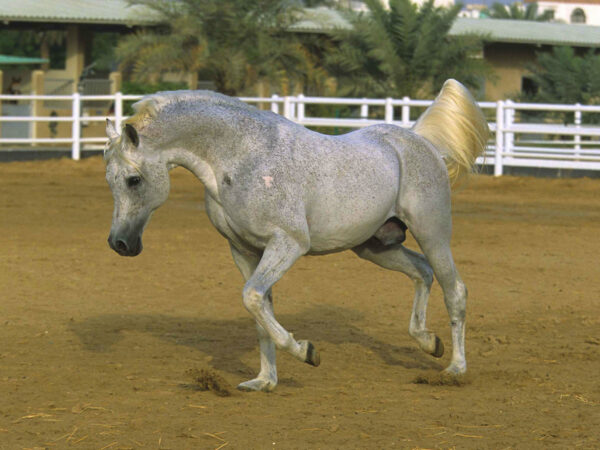
Sheikh Zayed was once quoted as saying: “Over the past 30 years, I have taken great pains to collect horses of the best bloodlines from all over the world; horses of great beauty, of speed and of endurance.” The latest arrival fitted perfectly into this category, the supreme athlete, Drug (Prizrak x Karinka). This 1985 grey stallion was imported to the UAE in 2000. Drug raced 35 times in his racing career spanning five seasons and placed first a phenomenal 13 times. He was awarded European Racehorse of the Year in 1989, a title he collected again in 1990 – the same year he was named European Champion Stallion in halter; quite an achievement.
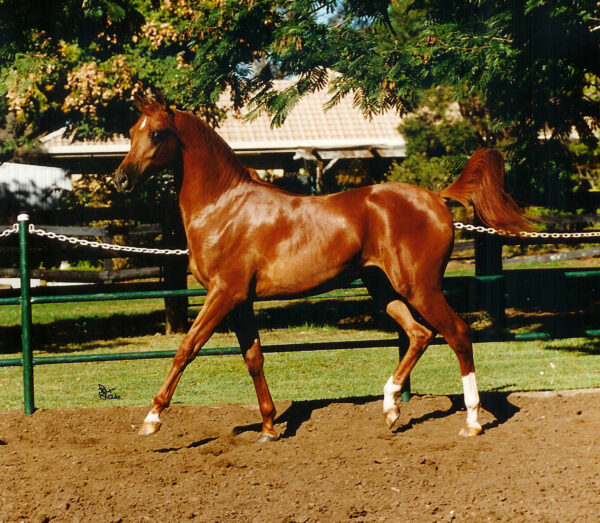
Another class horse landed on this small piece of paradise from Australia, Centre Highwayman (Desperado x Centre Mantilla) East Coast Champion and later UAE Champion Stallion. He left a quiet influence at the stud.
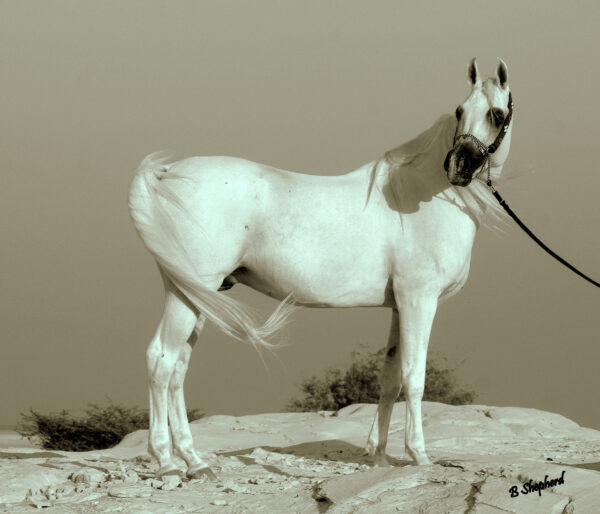
The last ingredient to be added was the straight Egyptian stallion Da Vinci KA (Makhsous x DB Shahlaha), foaled in 1997, bred by Kheilan Arabians and imported from the US. This typey, correct horse has crossed extremely well with the Crabbet-bred mares, adding dryness, structure, and refinement without compromising the mare’s dominance
The glory years
Racing has long been known as the Sport of Kings and with endurance being dubbed the Sport of Sheikhs the Royal Stables, with Sheikh Zayed’s backing, has helped to bring both these disciplines to the fore. Ash’aab was duly furnished with a brand new endurance facility complete with exercise tracks and one of the first equine pools and a team of local bred and newly acquired horses; they soon became a formidable force in the endurance field. The original Arab and imported Russian mares crossed exceptionally well with French stallions to produce some superb racehorses notably RS Fayeq (Ne Rien Prendre x FA Protea), RS Dahrooj (Pavot Al Maury x Dujmovoshka), RS Tawoos (Ne Rien Prendre x Bahraini bred mare Tuwaisah), and RS Kerim (Bibi De Carrere out of Kontrolnaia) to name but a few, and these horses seemed unstoppable.
On the showing side, 1999 saw the arrival of a young trainer from England. With unlimited enthusiasm, Barry Shepherd took the show horses to even greater heights. This new partnership dominated the show arenas across the Gulf and firmly put the Royal Stables back on its throne.
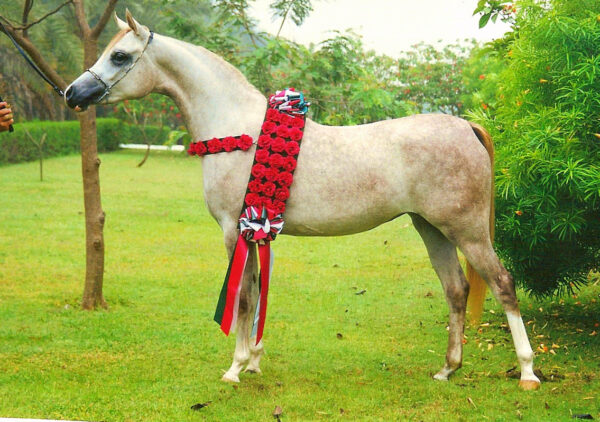
Burkan became the flagship horse for the Royal Stables and, in turn, the UAE and conquered all before him. Batala was one of the first horses to get the Royal Stables international recognition when she became Qatar International Arabian Horse Show Champion Filly. The 2000 exquisite beauty RS Ghaziya (Burkan x Gariah), serenely regal and proud, was UAE National Champion Filly in 2002 and 2005 UAE National Champion Reserve Mare along with a whole host of other awards.
The divine grey RS Banafsaj was highly-decorated and dubbed the ‘princess of the Gulf’. She was the crowd’s darling wherever she went and with wins in Qatar, Jordan, Abu Dhabi, Sharjah, Ajman and Dubai, it is easy to see why! The 2002 bay colt RS Muhannad (Maleik el Kheil x Mamluka) wowed crowds and judges alike with his phenomenal showy attitude and amazing beauty. He won all before him and was named UAE National Champion as a yearling. He ended his youngstock career taking the class win at the Dubai International Show against the strongest competition. Meanwhile, the 2001 chestnut colt RS Adel (Centre Highwayman x Aseela) captured many titles with his explosive movement and unrivalled quality.

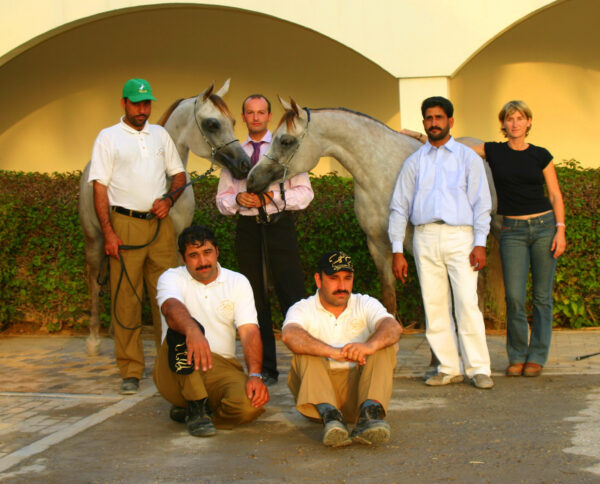
Final mention must go to the grey 2004 mare RS Kasiba (Da Vinci KA x Kaida), possibly the best-known and best-loved filly to come from this celebrated breeding farm. As a filly, she was beyond compare; in her two years of showing before the dispersal of the stud, she won the hearts and admiration of many top breeders and judges from around the globe. She won at every show that she competed in and culminated her career by being crowned UAE National Champion on her last appearance.
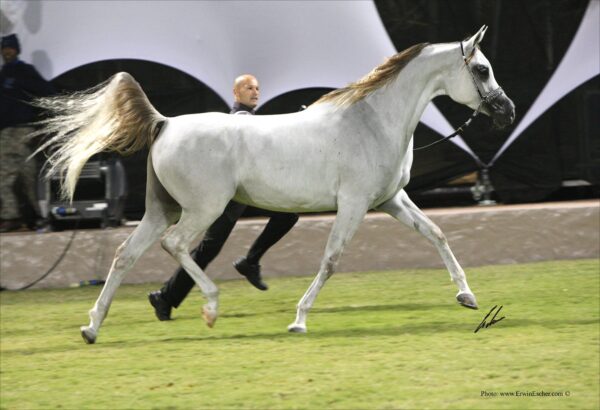
These horses were all owned, bred, and shown by the Royal Stables. They won against some of the best in the world, thus proclaiming their excellence.
A sad farewell
With a vast selection of bloodlines and careful blending, the Royal Stables managed to achieve a certain look that made a ‘RS’ horse stand apart from others. In short, they were beautifully balanced horses combined with classic type and an undeniable star quality. The excellence of marks given for movement indicates that the stud’s goal of breeding beautiful athletes was achieved. The Middle East has since become the melting pot of the very best horses in the world and the vision that HH Sheikh Zayed first laid down all those years ago, never waning to fashions and fads, should earn him his place as a testament for any breeder to follow.
Tuesday 2 November 2004 brought many changes to Abu Dhabi. The sad passing of HH Sheikh Zayed Bin Sultan Al Nahyan signalled the end of a great and inspirational leader and the nation mourned for 40 days. This tragic news brought with it the finale to his famed Royal Stables of Abu Dhabi, and it was HH Sheikh Zayed’s wish for his treasured possessions to be divided between his families. Slowly his vast estate was sorted and gradually one by one, a year later his dream collection of horses began to leave their birthplace and the tranquillity of the stud and had to restart their lives over. This decision was met with much controversy as some felt that as the nation’s stud, it should have remained as a tribute to their great leader. Years of careful selective breeding and precious bloodlines were being lost, but the five full brothers of HH Sheikh Hamdan Bin Zayed, along with their mother, generously donated their share of the top show and breeding horses to him in order to unite their father’s vision via Sheikh Hamdan’s Al Aryam Arabians stud farm in Abu Dhabi.
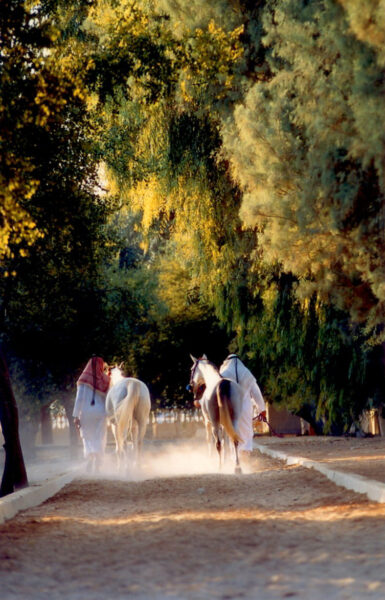
With nearly 30 of the most coveted horses going to Al Aryam, it signified a bright new future for these much-adored treasures. Al Aryam Arabians had representatives of each original family that HH Sheikh Zayed took great pride to reintroduce to the land of their forefathers. It now lay with HH Sheikh Hamdan to recreate his father’s most cherished dream, and his life’s work and vision will continue as Al Aryam recreates the future by using the history of the past.
The future
This feature was written in 2009, and things have evolved considerably since then. Al Aryam Arabians has gone on to shine in both Europe and the Middle East, while Al Shiraa Stables, founded by the late Sheikh Zayed’s granddaughter, Her Highness Sheikha Fatima Bint Hazza Bin Zayed Al Nahyan, has grown to be an internationally competitive farm with success both in the UAE and abroad.
Perhaps the greatest legacy from Sheikh Zayed’s vision is the number of small breeders who now proudly own, breed and show their Arabian horses. The number of farms across the Emirates has grown so much in the past 10 years or more, and that all comes down to the vision of one dedicated man, the Father of the UAE, the visionary that was Sheikh Zayed.


